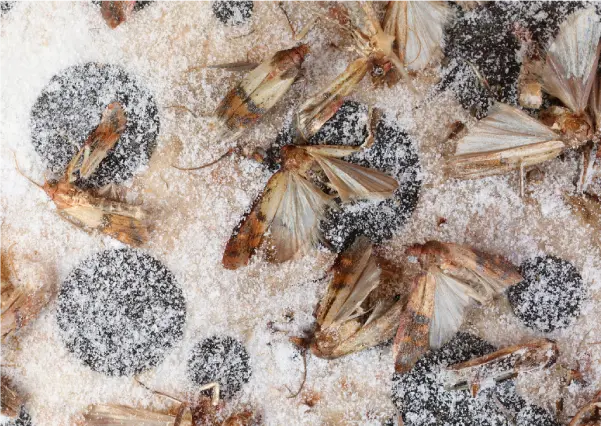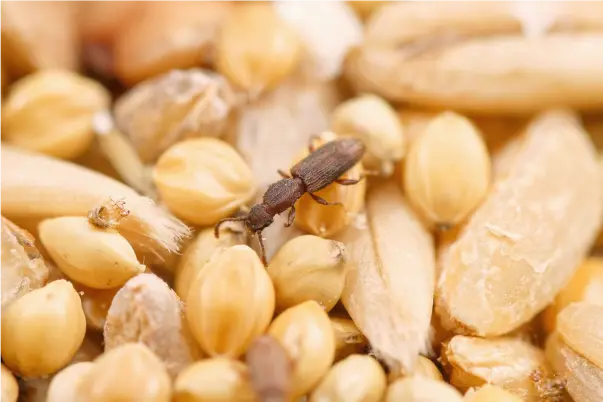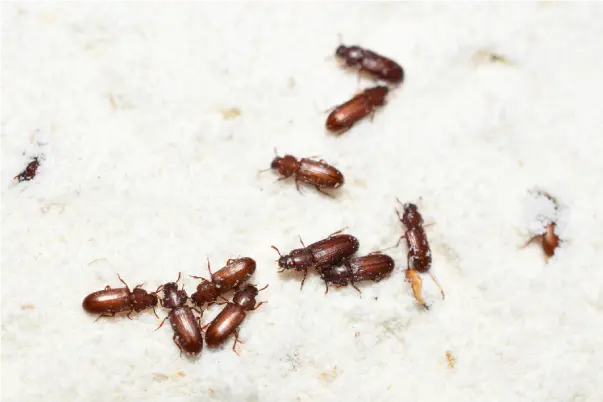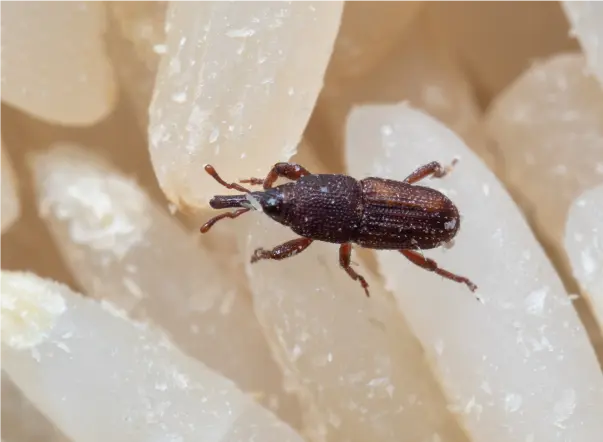Stored Product Pests: The Unwanted Dinner Guests!
You open your flour, rice, or cereal—only to find tiny bugs crawling where they don’t belong. Yikes! Stored product pests, like weevils, moths, and beetles, can hitch a ride into your home through infested food packages and quickly spread throughout your pantry. These sneaky invaders love dry goods like grains, pasta, nuts, and pet food, turning your groceries into their personal buffet. But don’t panic! With the right prevention, storage techniques, and professional pest control, you can keep your kitchen pest-free and ensure your food stays for you—not for them!
Stored Product Pest Control & Prevention
Stored Product Pests or also known as Pantry pests is a broad term for a variety of insects that infest and damage dry goods in your home or business. If you have noticed tiny reddish beetles, small tan moths, or tiny worms in your kitchen—or accumulating on your windowsill—you may have a stored product pest infestation. These pests can hitch a ride in packaged foods, multiply quickly, and contaminate your pantry staples.
 Comprehensive Site Inspection
Comprehensive Site Inspection
- Our pantry pest control process begins with a detailed inspection to:
- Identify the specific pest species responsible for the infestation
- Locate contaminated food sources, including dry goods, spices, pet food, and hidden infestations
- We work systematically with you to inspect all stored food items, ensuring that any infested products are identified and removed
- If you’re conducting your own inspection before our visit, save any specimens in a sealed plastic bag or jar for identification
Effective Stored Product Pest Control Measures
- After confirming an infestation, we implement targeted control methods, including:
- Strategic use of pheromone traps to monitor and capture adult pests
- Limited material applications in high-risk areas (if necessary) to eliminate lingering pests
- Guidance on proper food disposal and storage to break the infestation cycle
Long-Term Prevention & Protection
- Our goal is not just to eliminate the current infestation but to prevent future outbreaks
- We offer ongoing monitoring services, including:
- Routine pheromone trap placement to catch early signs of activity
- Expert advice on sanitation, proper food storage, and moisture control to keep pests away
Our comprehensive stored product (pantry) pest control services ensure that your home or business stays pest-free and your stored food remains safe from contamination. Call us today for an inspection and expert pest protection!
Expert Stored Product Pest Control Services
While stored product pests do not spread disease or pose direct physical harm, they can quickly contaminate your food supply, making groceries unusable and leading to frustration. Infestations persist until the source is found and removed, as these pests continue to breed within stored products.
Our approach focuses on:
- Identifying and eliminating infested food sources, which is the key to stopping the infestation
- Targeted treatments to help reduce live activity and prevent secondary infestations
- Providing expert guidance on food storage and sanitation to ensure long-term protection
By addressing both the current infestation and potential future risks, we help keep your kitchen pest-free and your food safe. Contact us today for professional stored product pest control solutions!
- Quarterly & Bi-Monthly Programs
- Target Pests: Ants, spiders and various other crawling insects
-
Service Includes:
- Exterior perimeter inspection and application for crawling insect control
- Removal of accessible wasp nests on the structure of your home
- Sweeping of spider webs followed by an overhead application for spider control
- Interior services as needed
- Quarterly & Bi-Monthly Programs
- Target Pests: Rats, mice, ants, spiders and various other crawling insects.
-
Service Includes:
- Exterior perimeter inspection and application for crawling insect control
- Removal of accessible wasp nests on the structure of your home
- Sweeping of spider webs followed by an overhead application for spider control
- Service exterior rodent bait stations and inspect for potential entry points
- Interior services as needed
- Quarterly & Bi-Monthly Programs.
- Target Pests: Rats & Mice.
-
Service Includes:
- Exterior perimeter inspection for potential entry points, nesting areas or food sources.
- Seal up identified entry points to prevent the rodents from accesses the interior of your home.
- Service exterior and interior rodent bait stations.
- Interior services as needed.
Identification
Stored Product Pest Identification
Stored Product Pests are a group of insects, primarily beetles and moths, that infest stored food and organic materials, causing contamination and waste. These pests can be surprisingly destructive, thriving in everyday pantry staples and even hidden sources you might not expect.
How Do Stored Product Pests Get Inside?
○ They often hitch a ride into your home through contaminated pet food, grains, flour, or packaged goods
○ Some species may enter from bird nests in attics or even abandoned yellowjacket or rodent nests in crawlspaces, where they feed on organic debris before spreading indoors
○ Once inside, they multiply quickly, making a thorough inspection and early identification crucial for effective control
Common Stored Produc Pests:
○ Beetles – Flour beetles, sawtoothed grain beetles, drugstore beetles, cigarette beetles, merchant grain beetles, granary weevils
○ Moths – Indian meal moths, Mediterranean flour moths
Because these pests can originate from multiple sources, a comprehensive inspection is essential to locate the infestation and prevent it from spreading further into your home. If you are noticing signs of stored product pests, contact us today for expert identification and targeted treatment!
Common Types of Stored Product Pests & How to Identify Them
Indian Meal Moth (Plodia interpunctella)
- Size: About ½ inch long with a ¾-inch wingspan
- Coloration: Forewings are two-toned, with a distinctive bronze or coppery lower half and a pale cream-colored upper half
- Larvae: Small, whitish or pinkish caterpillars, often found inside infested food packages or crawling on pantry walls and ceilings
 Signs of Infestation:
Signs of Infestation:
- Webbing in food packaging (a key indicator of infestation)
- Small moths flying near pantry shelves or kitchen lights
- Larvae crawling on surfaces near stored food
Sawtoothed Grain Beetle (Oryzaephilus surinamensis)
- Size: 1/10 inch long (tiny and flat-bodied)
- Coloration: Dark brown with six saw-like teeth along each side of the thorax
- Larvae: Pale, worm-like, and less than ⅛ inch long
Signs of Infestation:
- Tiny, fast-moving beetles in flour, cereals, rice, pasta, nuts, or pet food
- Small piles of fine, powdery frass (insect waste) in stored goods
- Beetles crawling along pantry shelves, packaging, or food storage containers
 Flour Beetles (Tribolium spp.)
Flour Beetles (Tribolium spp.)
- Size: About ⅛ inch long
- Coloration: Reddish-brown with elongated, oval-shaped bodies
- Larvae: Small, yellowish-white worms found inside infested products
Signs of Infestation:
- Contaminated flour, cereals, grains, and baking mixes with a musty or foul odor
- Presence of live or dead beetles inside stored food
- Flour that appears clumped together due to beetle activity
How to Prevent Stored Product Pests:
- Inspect all dry goods before bringing them home—especially bulk items and pet food
- Store food in airtight containers to prevent pest access
- Regularly rotate pantry items and use older products first to reduce risk
- Dispose of infested items immediately to stop the spread
If you notice any of these pantry pests, act fast! Contact us today for expert identification and effective stored product pest control solutions.
Risks
The Hidden Dangers of Stored Product Pest Infestations
While stored product pests may seem like a minor nuisance, their larval stage is where the real damage occurs. These tiny invaders can contaminate a wide range of food products, rendering them inedible and unsafe.
What Do Stored Product Pests Infest?
Certain beetles and moths target a variety of dry goods and household items, including:
- Beetles (Carpet beetles, drugstore beetles, merchant grain beetles, granary weevils, flour beetles, and cigarette beetles) – Can infest pet food, grains, spices, pasta, cereals, prescription drugs, and even toxic materials.
- Moths (Indian meal moths and Mediterranean flour moths) – Primarily infest flour, cornmeal, seeds, nuts, and breakfast cereals.
How Infestations Go Unnoticed
- Many infestations are undetected for months or even years, especially in rarely used food items
- Infestations often flourish in forgotten dry goods, such as the back of a pantry, old baking supplies, or bulk-stored grains
- The longer the larvae feed, the more contamination occurs, increasing the risk of a widespread infestation
Preventing & Controlling Pantry Pests
- Regularly inspect and rotate stored food, ensuring older products are used first
- Store dry goods in airtight containers to prevent infestations
- Dispose of contaminated food promptly to stop the infestation cycle
If you suspect stored product pest activity, don’t wait until the problem spreads! Contact us today for a professional inspection and customized pest control solutions to keep your food safe and your home or business pest-free.
Stored Product Pest Control Methods
Stored Product pests live, feed, and breed directly inside stored food, making them difficult to detect until the infestation has spread. By the time you notice insects crawling in your kitchen, they have likely produced hundreds of offspring, requiring a thorough inspection and removal of infested products to fully resolve the problem.
Challenges in Stored Product Control
- Stored Product pests can infest factory-sealed bags and containers, sometimes leaving only a tiny hole the size of a pencil tip as evidence.
- Without locating and removing the source, the infestation will persist, as pests will continue breeding inside contaminated products.
- Once the infested items are eliminated, we use pheromone traps and limited material applications to control lingering pests and reduce the risk of re-infestation.
Professional Pest Identification & Inspection Assistance
- Our experts can identify the specific pest species and inspect the area to help determine which food items should be checked and discarded.
- The more potentially infested items you remove, the faster and more effective the overall control process will be.
- Unless the contaminated items have significant monetary or sentimental value, we strongly recommend disposal to prevent the infestation from spreading further.
Pests Can Hide in Unexpected Places
- Forgotten Halloween candy, old snack boxes, or an unopened package of flour in the back of the pantry can all be unexpected infestation sources.
- Infestations have even been found in crumbs and loose food debris under or behind stoves and refrigerators.
- Because the inspection process can be time-consuming, we highly recommend scheduling a professional assessment for accurate identification and targeted control.
If you suspect stored product pests in your home or business, do not wait for the problem to escalate! Contact us today for expert inspection, identification, and treatment solutions to keep your kitchen pest-free.
Prevention Tips
Stored Product Pest Prevention Tips
Preventing stored product pests requires proactive measures to eliminate food sources, maintain cleanliness, and monitor activity. By following these simple steps, you can reduce the risk of infestations and keep your kitchen pest-free.
 Keep Food Properly Stored & Maintain Cleanliness
Keep Food Properly Stored & Maintain Cleanliness
- Store dry goods in airtight containers to prevent pantry pests from accessing food sources.
- Clean up spills and crumbs immediately, especially in pantries and kitchen cabinets, to remove attractants.
- Regularly check and discard expired or stale food items that could harbor pests.
Rotate & Inspect Stored Food
- Follow a “first in, first out” system—use older products before newer ones to prevent long-term storage of potentially infested items.
- Inspect dry goods before purchasing and again before storing—look for signs of insect activity such as tiny holes, webbing, or frass (insect waste).
Expect Some Post-Treatment Activity
- After professional treatment, you may notice an increase in pest activity for 2-4 weeks—this is normal as remaining pests emerge and are exposed to treatments.
- If activity persists beyond the expected time frame, contact us for a follow up inspection.
Maintain & Monitor Insect Traps
- If we have placed pheromone or sticky traps, leave them undisturbed so we can track pest activity levels.
- These monitors help us assess the effectiveness of treatments and adjust pest control measures as needed.
Report Any Persistent Activity Promptly
- If you continue seeing pantry pests despite following prevention steps and treatment, let us know right away.
- Timely communication ensures we can provide additional support, reassess conditions, and take further action if needed.
By following these prevention strategies, you can greatly reduce the likelihood of future infestations and maintain a pest-free pantry. Need help? Contact us today for expert stored product pest control solutions!

